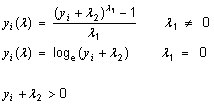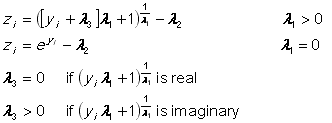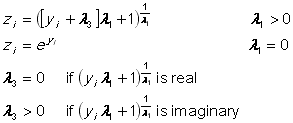| Constructors
|
|
public BoxCox(double[] ydata)
|
public BoxCox(float[] ydata)
|
public BoxCox(int[] ydata)
|
public BoxCox(long[] ydata)
|
public BoxCox(short[] ydata)
|
public BoxCox(byte[] ydata)
|
public BoxCox(BigDecimal[] ydata)
|
public BoxCox(BigInteger[] ydata)
|
public BoxCox(ArrayMaths ydata)
|
public BoxCox(ArrayList<Object> ydata)
|
public BoxCox(Vector<Object> ydata)
|
public BoxCox(Stat ydata)
|
| Analysis
|
Box-Cox transform and full anlysis |
public void analysis()
|
| public void analysis(String fileTitle)
|
| Transformed Data
|
Transform data with best estimates of λ1 and λ2 |
public double[] transform()
|
| Scaled transformed data |
public double[] scaledTransformedData()
|
| Ordered scaled transformed data |
public double[] orderedScaledTransformedData()
|
| Standardized transformed data |
public double[] standardizedTransformedData()
|
| Transformed data |
public double[] transformedData()
|
| λ1 |
public double lambdaOne()
|
| λ2 |
public double lambdaTwo()
|
| Gaussian Probability Plot |
Display plot |
public void transformedProbabiltyPlot()
|
| Correlation coefficient |
public double transformedCorrelationCoefficient()
|
| Gradient |
public double transformedGradient()
|
| public double transformedGradientError()
|
| Intercept |
public double transformedIntercept()
|
| public double transformedInterceptError()
|
| Mean |
public double transformedMean()
|
| Standard deviation |
public double transformedStandardDeviation()
|
| Standard error of the mean |
public double transformedStandardError()
|
| Moment skewness |
public double transformedMomentSkewness()
|
| Median skewness |
public double transformedMedianSkewness()
|
| Quartile skewness |
public double transformedQuartileSkewness()
|
| Excess kurtosis |
public double transformedExcessKurtosis()
|
| Median |
public double transformedMedian()
|
| Minimum |
public double transformedMinimum()
|
| Maximum |
public double transformedMaximum()
|
| Range |
public double transformedRange()
|
| Fixed Value Transform
|
Transform data with user supplied values of λ1 and λ2 |
public double[] fixedValueTransform(double lambdaOne, double lambdaTwo)
|
| public double[] fixedValueTransform(double lambdaOne)
|
| Inverse Transform
|
Perform inverse transform |
public double[] inverseTransform(double lambdaOne, double lambdaTwo)
|
| public double[] inverseTransform(double lambdaOne)
|
| Shift factor |
public double lambdaThree()
|
| Original Data
|
Original data |
public double[] originalData()
|
| standardized original data |
public double[] standardizedOriginalData()
|
| Sorted original data |
public double[] sortedOriginalData()
|
| Shifted standardized original data |
public double[] shiftedStandardizedOriginalData()
|
| Gaussian Probability Plot |
Display plot |
public void originalProbabiltyPlot()
|
| Correlation coefficient |
public double originalCorrelationCoefficient()
|
| Gradient |
public double originalGradient()
|
| public double originalGradientError()
|
| Intercept |
public double originalIntercept()
|
| public double originalInterceptError()
|
| Mean |
public double originalMean()
|
| Standard deviation |
public double originalStandardDeviation()
|
| Standard error of the mean |
public double originalStandardError()
|
| Moment skewness |
public double originalMomentSkewness()
|
| Median skewness |
public double originalMedianSkewness()
|
| Quartile skewness |
public double originalQuartileSkewness()
|
| Excess kurtosis |
public double originalExcessKurtosis()
|
| Median |
public double originalMedian()
|
| Minimum |
public double originalMinimum()
|
| Maximum |
public double originalMaximum()
|
| Range |
public double originalRange()
|
| Set the variance denominator
|
Set denominator to n |
public void setDenominatorToN()
|


 and s are the mean and standard deviation of the yi.
and s are the mean and standard deviation of the yi.


 and s are the mean and standard deviation of the yi.
and s are the mean and standard deviation of the yi.



 and s are the mean and standard deviation of the yi.
and s are the mean and standard deviation of the yi.

 and s are the mean and standard deviation of the yi.
and s are the mean and standard deviation of the yi.
